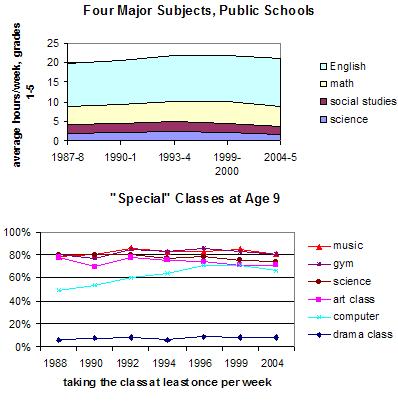« exit poll predictions | Main | what publics do »
February 8, 2008
the narrowing of the curriculum
These two graphs indicate that the elementary school curriculum in the US has narrowed somewhat (not dramatically) in recent years. The first graph shows hours devoted to four major subjects throughout grades 1-5; the second tracks the percentage of kids who experience various "special" classes such as art and music. We see an increase in all the academic subjects and some of the "specials" in the 1980s and 1990s, as Americans became concerned about slackness in the whole education system. This was followed by a narrowing of the curriculum as the available time went into reading and math and away from social studies and arts after 1992-4.
Although these trends are not dramatic, I think they deserve public discussion. The cause is more than the No Child Left Behind Act, because the narrowing trend began before NCLB was enacted and is evident in private schools as well as public schools. I associate the narrowing with a whole set of decisions made by local, state, and federal authorities, teachers, schools of education, textbook publishers, and families.
Here are four perspectives that these stakeholders ought to consider and discuss.
1. Back to basics. Reading and math are fundamental. Performance in these subjects is inadequate for the whole population and very unequal. We need to focus our attention on these subjects until all kids can read, write, and calculate. The trends shown above are desirable.
2. The liberal arts. Education today is too instrumental. It's all about outcomes, especially economic outcomes. It overlooks the intrinsic value of subjects like history, fine arts, natural sciences, foreign languages, and current events. Although such topics can be taught under the heading of "reading," in fact reading instruction emphasizes skills, not content. Thus the trends shown above indicate a decline in the liberal arts.
3. Cultural literacy. The only way to be literate is to have a base of facts, concepts, and vocabulary. We obtain that base best by studying history, natural science, social science, and foreign cultures. The trends shown above mean that we are failing to emphasize cultural literacy and that is why reading scores are flat despite increased time devoted to reading/language arts.
4. Civic mission. The purpose of schools is not (only) to prepare workers, but also to create an active and egalitarian democracy. That mission requires widespread literacy and numeracy. But it also requires specific knowledge of history, government, social issues, and current events. Such knowledge also correlates empirically with using and enjoying the arts. We are losing those elements of the curriculum.
February 8, 2008 11:09 AM | category: none
Comments
Peter:
Thanks for posting this data I will use it. As we hold conversations with parents and non-parents in communities around the country they talk a lot about how they perceive that the curriculum has narrowed. It is widely believed/perceived to be true and there are deep aspirations for schools to pay attention to developing the "whole child".
Interestingly they also want rigorous curriculum. What is most striking to me is that they will complain a lot about how there isn't enough time to do the things they think should be done. But it is very rare that someone will suggest that we add hours to the school day or days to the school year. The acceptance of the current school year calendar and the 6 hour school day is deeply held.
There is a big hurdle facing those who believe the school day and/or year should be longer.
David Moore
February 8, 2008 8:31 PM | Comments (1) | posted by mooredp
